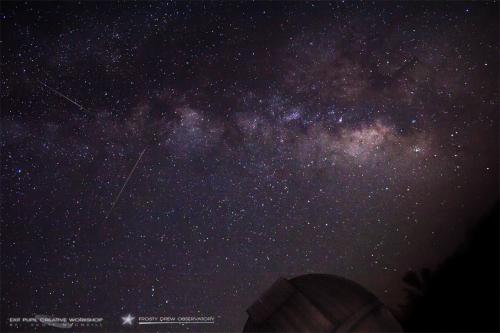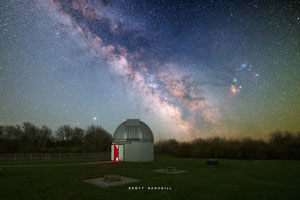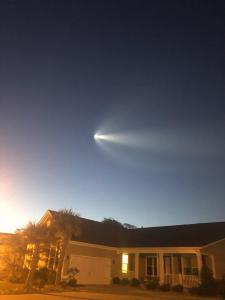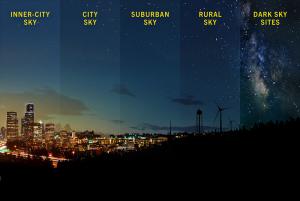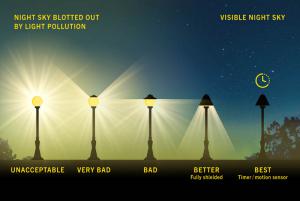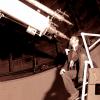Celebration of Space - April 14, 2023
Starting tomorrow, April 15, 2023, the annual Lyrid Meteor Shower will begin. The first meteor shower of the meteor viewing season, the Lyrid shower often surprises viewers, if conditions are optimal, and in 2023, they are certainly optimal.
The Lyrid shower will run until April 29, 2023, with a peak date of April 23, 2023, in the morning hours before predawn. During the peak period, the shower can bring upwards of 20 meteors per hour when viewed from a dark location without the presence of the Moon. Lyrid meteors originate from the comet C/1861 G1 Thatcher, which leaves a trail of comet debris along its orbit. Earth will orbit through this debris field every April, allowing for tiny dust and rice sized pieces of comet to enter Earth’s atmosphere and burn up. When viewing the shower, meteors will appear to radiate from a point in the sky near the super bright star Vega in the constellation Lyra.
Another reason why the Lyrid Meteor Shower is so spectacular at Frosty Drew Observatory, is because April is the best month to see the Milky Way over our location. Being that the Lyrid shower will peak in the morning hours before sunrise, viewers will have access to a stunning view of the Milky Way stretching across the morning sky.
The Moon is currently waning towards the New Moon. After which, the Moon will be in the evening sky, making for excellent viewing conditions of the Lyrid shower. It should also be noted that the second meteor shower of the season, the Eta Aquariid Meteor Shower, also kicks in on April 15th, and runs until May 27th. Though the peak night is not until May 5-6th, the presence of Eta Aquariid meteors will make the Lyrids appear a bit more active. We will write about the Lyrids again next week with instructions on how to get the best view. Until then, keep looking up on those clear nights.
This coming Thursday, April 20, 2023 at 12:16 am ET, the Moon will arrive, in its orbit, in between the Sun and the Earth. We call this “conjunction”, but you may have heard it called the New Moon. On that day, the Moon will rise and set with the Sun. The side of the Moon that we see will be in full shadow (nighttime), with the opposite side in full sunlight (daytime). The New Moon is very difficult to observe because it is so close to the Sun in the sky. It is possible, but not recommended, as you risk damage to your retina from looking so close to the Sun. Being that the Moon will rise and set with the Sun, the nighttime period will have no Moon present, making it the darkest night of the 29.5 lunar synodic period. The synodic period is the time it takes for the Moon to go from new to full and back to new. It is about 2 days longer than the orbital period of the Moon, called the lunar sidereal period (27.3 days). The difference in length is due to Earth progressing in its orbit around the Sun during those 27.3 days. If the sky is clear on Thursday night, be sure to step out and enjoy the starscape. Starting on the 21st, the Moon will be sporting a super thin waxing crescent in the evening dusk sky.
This coming Tuesday, April 18, 2023, the SpaceX Falcon Heavy launch vehicle will depart from Kennedy Space Center, Florida. It will be carrying VistaSat Americas broadband communications satellite to orbit. This launch is notable because it is scheduled to occur between 7:29 pm – 8:26 pm, which is right around the 7:30 pm sunset time. SpaceX is famous for launching their rockets right after sunset or right before sunrise. This will place the rocket in direct sunlight, while observers on the ground are in dusk or twilight. The result is a stunningly bright display of the rocket and the exhaust plumes. We are unsure if the rocket will be visible from our location, but it is quite possible, and well worth an attempt at viewing. Depending on the path the rocket takes, it could pass quite high in the sky, or lower on the horizon. The best bet for a view is to set out to a location with a good view of the South → West horizon, and be there for 7:15 pm. Keep an eye to the SW sky until 8:26 pm, and look for a fast moving star with a large plume of vapor. If you catch a view, let us know.
This morning, April 14, 2023, the European Space Agency (ESA) launched the Jupiter Icy Moons Explorer (JUICE) spacecraft. The JUICE mission is destined for the Galilean Moons of Jupiter, specifically the three icy moons (Europa, Ganymede, and Callisto). With a special emphasis on the moon Ganymede. The goal of the mission is to study the icy moons of Jupiter from the point of view of potential habitats. The spacecraft will not arrive at the Jovian system for another 7.6 years, after which it will spend 3.5 years studying the Jovian system. Next year, 2024, NASA will launch the Europa Clipper mission, which will study Jupiter’s icy moon, Europa. Both spacecraft will be in the Jovian system simultaneously. We will periodically offer updates on these missions as significant events occur. In the meantime, take a moment to learn more about the JUICE mission.
Starting Saturday, April 15th, and continuing until Saturday, April 22nd, International Dark Sky Week is happening. This is a week to raise awareness of the problems that light pollution causes, and the effects that it has on the habitability of planet Earth. Of all the climate change issues, light pollution is probably the easiest to fix. Nearly everyone is contributing to this problem, and most do not even realize they are.
Over the years, the misinformation regarding lighting has become rampant. The idea that lighting is required for safety is fictional, as most crime happens in daylight or heavily illuminated areas (criminals are not gifted with spectacular night vision.) Fear of the dark is a late 20th century and 21st century problem that stems from the inability to distinguish fiction from reality. Humanoid life has been on Earth for 11 million years, artificial lighting has only been here for about 150 years. I often ask people “how did we ever make it for 11 million years without lighting?!”
We have evolved with a light and dark daily schedule. Excessive lighting is unnatural, unhealthy, and poor denizenship, and in some cases bad citizenship. Lighting also begets lighting. Human’s have a fantastic ability to see in the dark, but it takes about 10-20 minutes to become adjusted to the darkness. Historically, this was not a problem as twilight takes almost 90 minutes to wane, so our adjustment to the dark was seamless. In modern times, we do not give our eyes a chance to adapt to darkness because of all the artificial lights everywhere. Because of this, the moment we are out of the light glare, we can’t see, and feel like we need more light.
The beauty of the world at night reminds me of watching the movie Avatar, when everything at night changes. On Earth, we are so lucky to have had this amazing view of the cosmos and a planet that comes alive at night. But fear has caused us to discard this beauty in the name of false security. In doing so, we have not only ruined this beauty for our children, but also for every other species that inhabits this planet. Human’s do not own Earth, we are part of it, equally, with everything else. That’s why we call it an ecosystem.
I would sometimes like to say that we are too pretentious, entitled, and ignorant. But I don’t believe that is the truth. I think we are misinformed, and unaware that this problem even exists. So I challenge you this week to learn about the problem, identify how you are contributing to the problem, and how you can stop being a contributor and become part of the solution. Here is a great resource to understand the problem. The International Dark Sky Association (IDA) is the leading authority on solving the harmful effects of light pollution. Please take time this week to research this. And while you are at it, take a clear night this week to visit a spot that is truly dark, stand outside under the stars and let your eyes become adapted to the dark. You will be shocked at how amazing Earth is at night, where it is truly dark. The landscape comes alive with wildlife, and the sky will blaze the light of thousands of stars that make up our celestial neighborhood. You may see and hear owls, coyotes, bobcats, bats, reptiles, and birds. All of which will not attack you.
- Author:
- Scott MacNeill
- Entry Date:
- Apr 14, 2023
- Published Under:
- Scott MacNeill's Columns

